Case Study: Analysis of U.S. Trade Policies, Agreements, and Impact
VerifiedAdded on 2022/10/08
|6
|1289
|16
Case Study
AI Summary
This case study analyzes U.S. trade policies, focusing on the General Agreement on Tariffs and Trade (GATT), antidumping laws, the Generalized System of Preferences, and the Trans-Pacific Partnership (TPP). It explores factors of production (land, labor, capital), absolute and comparative advantage trade theories, and the impact of these policies on economic growth, standards of living, and international trade. The study also discusses the TPP agreement and its potential benefits for the U.S. economy. The assignment references various academic sources to support its analysis of these complex trade dynamics and their implications.
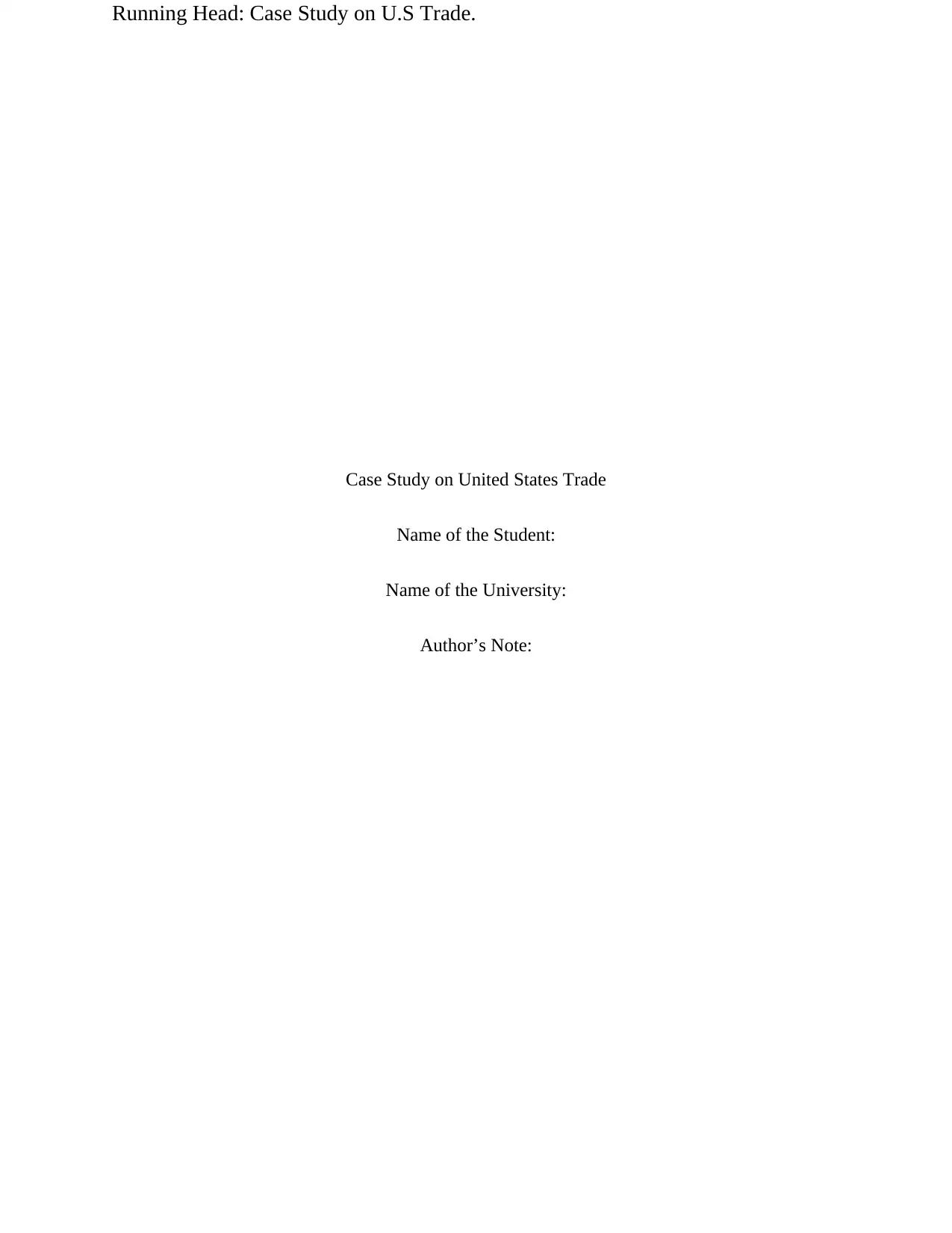
Running Head: Case Study on U.S Trade.
Case Study on United States Trade
Name of the Student:
Name of the University:
Author’s Note:
Case Study on United States Trade
Name of the Student:
Name of the University:
Author’s Note:
Paraphrase This Document
Need a fresh take? Get an instant paraphrase of this document with our AI Paraphraser
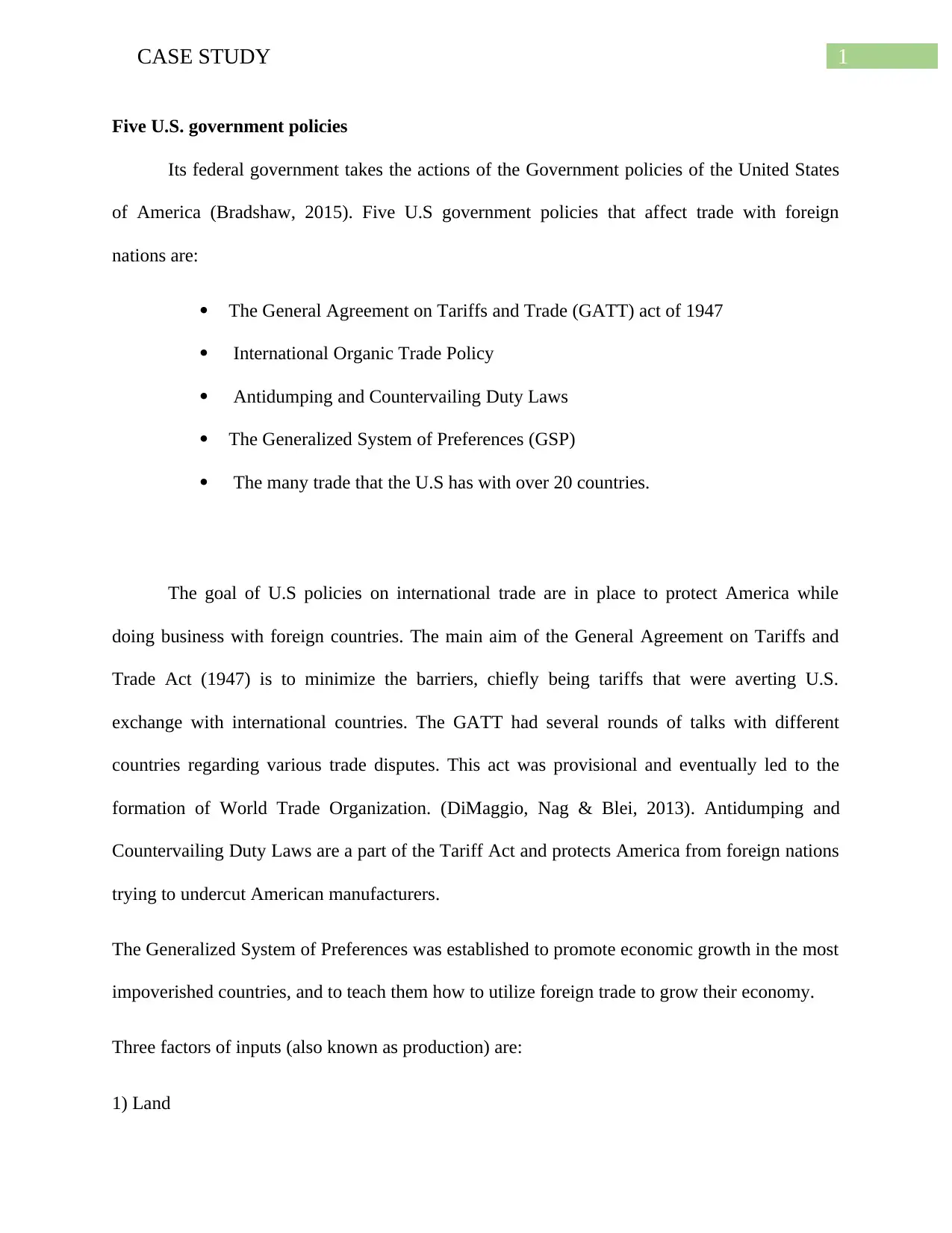
1CASE STUDY
Five U.S. government policies
Its federal government takes the actions of the Government policies of the United States
of America (Bradshaw, 2015). Five U.S government policies that affect trade with foreign
nations are:
The General Agreement on Tariffs and Trade (GATT) act of 1947
International Organic Trade Policy
Antidumping and Countervailing Duty Laws
The Generalized System of Preferences (GSP)
The many trade that the U.S has with over 20 countries.
The goal of U.S policies on international trade are in place to protect America while
doing business with foreign countries. The main aim of the General Agreement on Tariffs and
Trade Act (1947) is to minimize the barriers, chiefly being tariffs that were averting U.S.
exchange with international countries. The GATT had several rounds of talks with different
countries regarding various trade disputes. This act was provisional and eventually led to the
formation of World Trade Organization. (DiMaggio, Nag & Blei, 2013). Antidumping and
Countervailing Duty Laws are a part of the Tariff Act and protects America from foreign nations
trying to undercut American manufacturers.
The Generalized System of Preferences was established to promote economic growth in the most
impoverished countries, and to teach them how to utilize foreign trade to grow their economy.
Three factors of inputs (also known as production) are:
1) Land
Five U.S. government policies
Its federal government takes the actions of the Government policies of the United States
of America (Bradshaw, 2015). Five U.S government policies that affect trade with foreign
nations are:
The General Agreement on Tariffs and Trade (GATT) act of 1947
International Organic Trade Policy
Antidumping and Countervailing Duty Laws
The Generalized System of Preferences (GSP)
The many trade that the U.S has with over 20 countries.
The goal of U.S policies on international trade are in place to protect America while
doing business with foreign countries. The main aim of the General Agreement on Tariffs and
Trade Act (1947) is to minimize the barriers, chiefly being tariffs that were averting U.S.
exchange with international countries. The GATT had several rounds of talks with different
countries regarding various trade disputes. This act was provisional and eventually led to the
formation of World Trade Organization. (DiMaggio, Nag & Blei, 2013). Antidumping and
Countervailing Duty Laws are a part of the Tariff Act and protects America from foreign nations
trying to undercut American manufacturers.
The Generalized System of Preferences was established to promote economic growth in the most
impoverished countries, and to teach them how to utilize foreign trade to grow their economy.
Three factors of inputs (also known as production) are:
1) Land
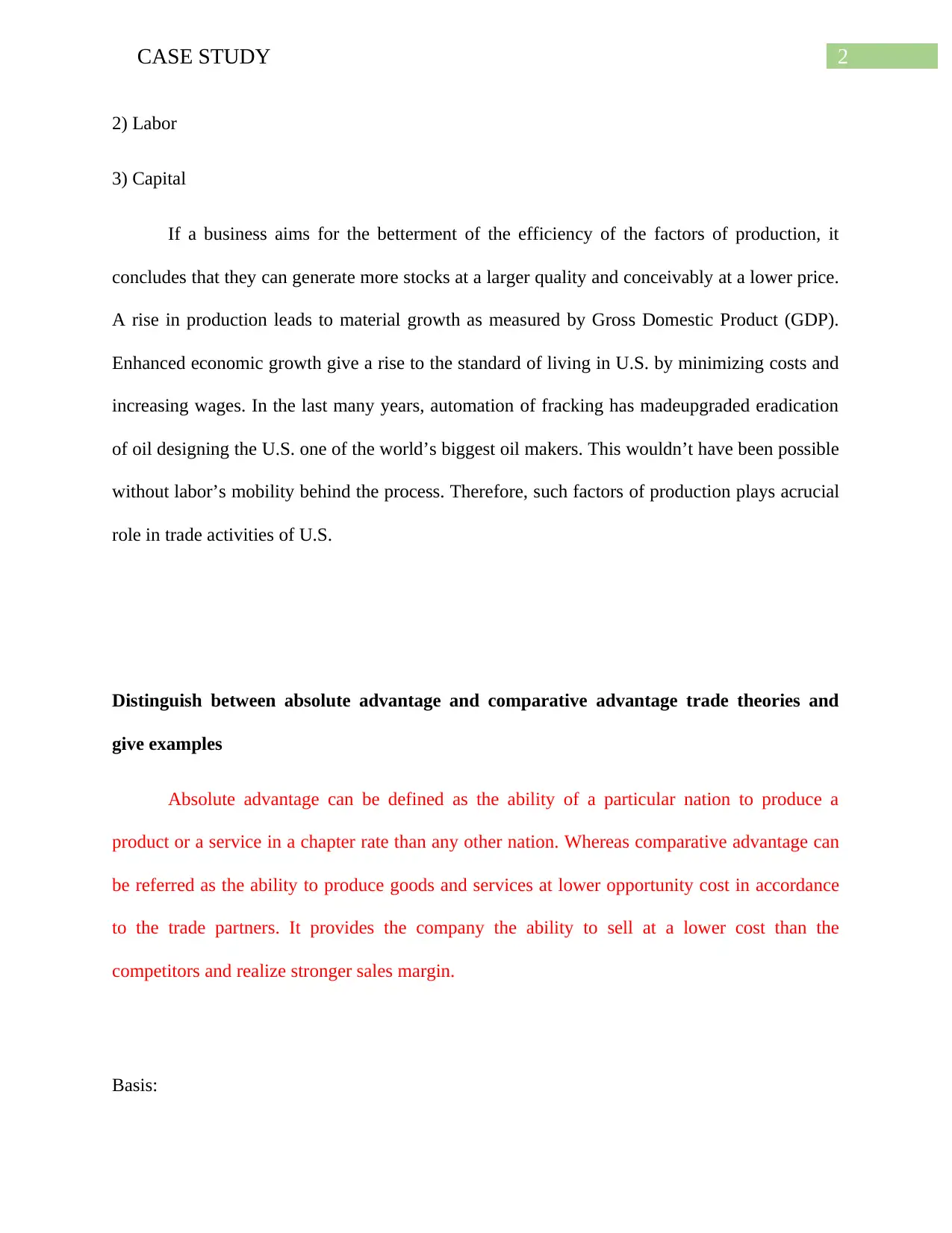
2CASE STUDY
2) Labor
3) Capital
If a business aims for the betterment of the efficiency of the factors of production, it
concludes that they can generate more stocks at a larger quality and conceivably at a lower price.
A rise in production leads to material growth as measured by Gross Domestic Product (GDP).
Enhanced economic growth give a rise to the standard of living in U.S. by minimizing costs and
increasing wages. In the last many years, automation of fracking has madeupgraded eradication
of oil designing the U.S. one of the world’s biggest oil makers. This wouldn’t have been possible
without labor’s mobility behind the process. Therefore, such factors of production plays acrucial
role in trade activities of U.S.
Distinguish between absolute advantage and comparative advantage trade theories and
give examples
Absolute advantage can be defined as the ability of a particular nation to produce a
product or a service in a chapter rate than any other nation. Whereas comparative advantage can
be referred as the ability to produce goods and services at lower opportunity cost in accordance
to the trade partners. It provides the company the ability to sell at a lower cost than the
competitors and realize stronger sales margin.
Basis:
2) Labor
3) Capital
If a business aims for the betterment of the efficiency of the factors of production, it
concludes that they can generate more stocks at a larger quality and conceivably at a lower price.
A rise in production leads to material growth as measured by Gross Domestic Product (GDP).
Enhanced economic growth give a rise to the standard of living in U.S. by minimizing costs and
increasing wages. In the last many years, automation of fracking has madeupgraded eradication
of oil designing the U.S. one of the world’s biggest oil makers. This wouldn’t have been possible
without labor’s mobility behind the process. Therefore, such factors of production plays acrucial
role in trade activities of U.S.
Distinguish between absolute advantage and comparative advantage trade theories and
give examples
Absolute advantage can be defined as the ability of a particular nation to produce a
product or a service in a chapter rate than any other nation. Whereas comparative advantage can
be referred as the ability to produce goods and services at lower opportunity cost in accordance
to the trade partners. It provides the company the ability to sell at a lower cost than the
competitors and realize stronger sales margin.
Basis:
⊘ This is a preview!⊘
Do you want full access?
Subscribe today to unlock all pages.

Trusted by 1+ million students worldwide
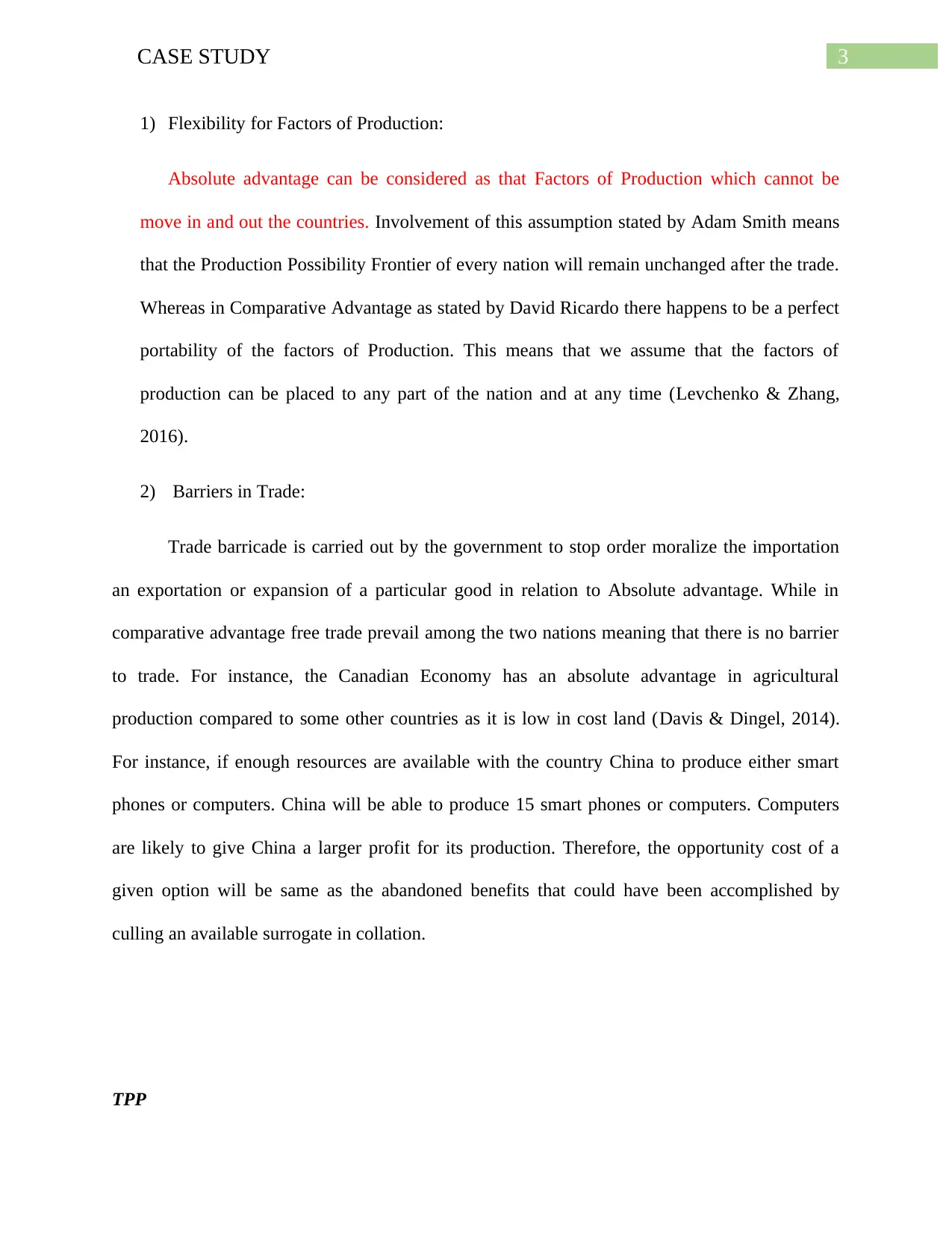
3CASE STUDY
1) Flexibility for Factors of Production:
Absolute advantage can be considered as that Factors of Production which cannot be
move in and out the countries. Involvement of this assumption stated by Adam Smith means
that the Production Possibility Frontier of every nation will remain unchanged after the trade.
Whereas in Comparative Advantage as stated by David Ricardo there happens to be a perfect
portability of the factors of Production. This means that we assume that the factors of
production can be placed to any part of the nation and at any time (Levchenko & Zhang,
2016).
2) Barriers in Trade:
Trade barricade is carried out by the government to stop order moralize the importation
an exportation or expansion of a particular good in relation to Absolute advantage. While in
comparative advantage free trade prevail among the two nations meaning that there is no barrier
to trade. For instance, the Canadian Economy has an absolute advantage in agricultural
production compared to some other countries as it is low in cost land (Davis & Dingel, 2014).
For instance, if enough resources are available with the country China to produce either smart
phones or computers. China will be able to produce 15 smart phones or computers. Computers
are likely to give China a larger profit for its production. Therefore, the opportunity cost of a
given option will be same as the abandoned benefits that could have been accomplished by
culling an available surrogate in collation.
TPP
1) Flexibility for Factors of Production:
Absolute advantage can be considered as that Factors of Production which cannot be
move in and out the countries. Involvement of this assumption stated by Adam Smith means
that the Production Possibility Frontier of every nation will remain unchanged after the trade.
Whereas in Comparative Advantage as stated by David Ricardo there happens to be a perfect
portability of the factors of Production. This means that we assume that the factors of
production can be placed to any part of the nation and at any time (Levchenko & Zhang,
2016).
2) Barriers in Trade:
Trade barricade is carried out by the government to stop order moralize the importation
an exportation or expansion of a particular good in relation to Absolute advantage. While in
comparative advantage free trade prevail among the two nations meaning that there is no barrier
to trade. For instance, the Canadian Economy has an absolute advantage in agricultural
production compared to some other countries as it is low in cost land (Davis & Dingel, 2014).
For instance, if enough resources are available with the country China to produce either smart
phones or computers. China will be able to produce 15 smart phones or computers. Computers
are likely to give China a larger profit for its production. Therefore, the opportunity cost of a
given option will be same as the abandoned benefits that could have been accomplished by
culling an available surrogate in collation.
TPP
Paraphrase This Document
Need a fresh take? Get an instant paraphrase of this document with our AI Paraphraser
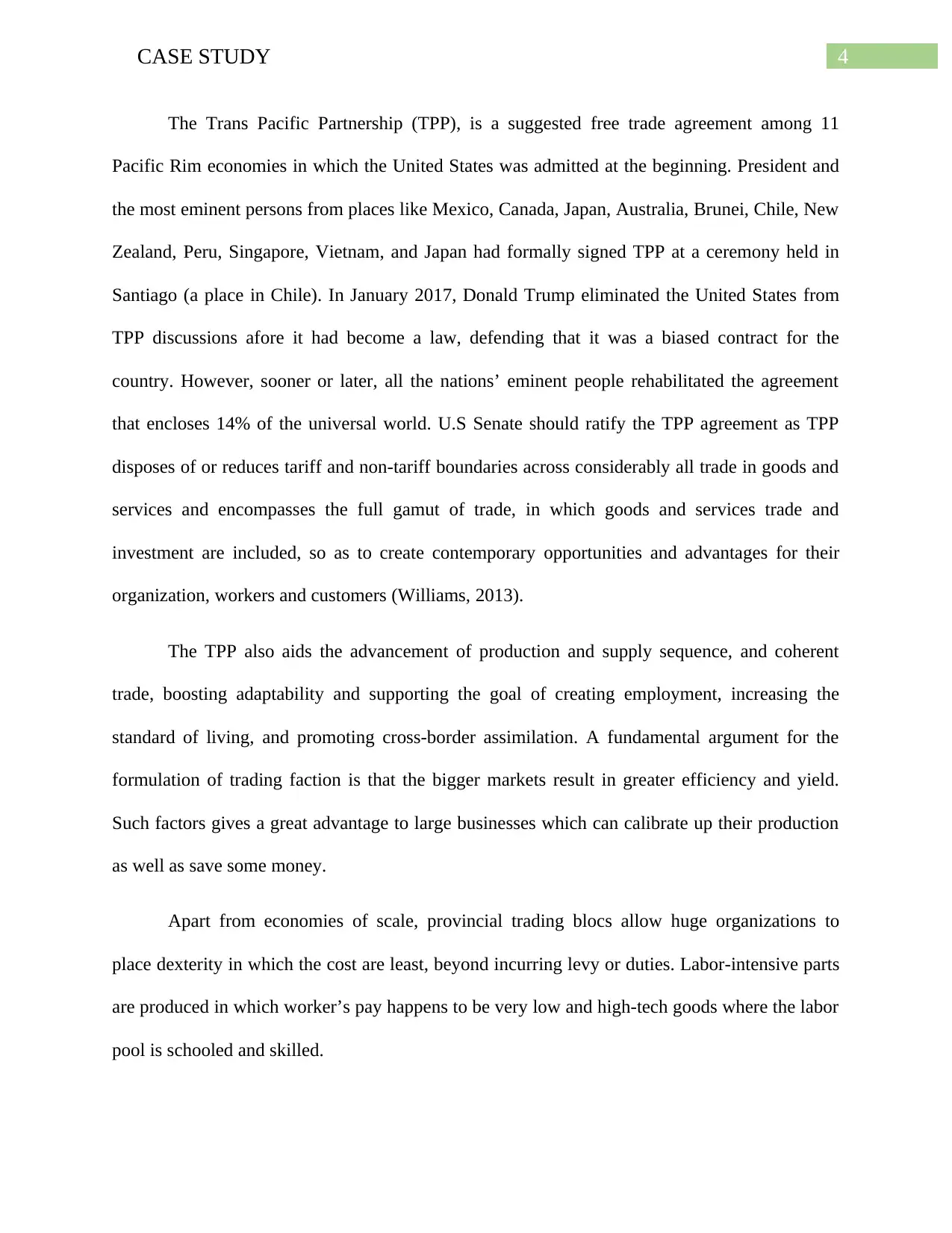
4CASE STUDY
The Trans Pacific Partnership (TPP), is a suggested free trade agreement among 11
Pacific Rim economies in which the United States was admitted at the beginning. President and
the most eminent persons from places like Mexico, Canada, Japan, Australia, Brunei, Chile, New
Zealand, Peru, Singapore, Vietnam, and Japan had formally signed TPP at a ceremony held in
Santiago (a place in Chile). In January 2017, Donald Trump eliminated the United States from
TPP discussions afore it had become a law, defending that it was a biased contract for the
country. However, sooner or later, all the nations’ eminent people rehabilitated the agreement
that encloses 14% of the universal world. U.S Senate should ratify the TPP agreement as TPP
disposes of or reduces tariff and non-tariff boundaries across considerably all trade in goods and
services and encompasses the full gamut of trade, in which goods and services trade and
investment are included, so as to create contemporary opportunities and advantages for their
organization, workers and customers (Williams, 2013).
The TPP also aids the advancement of production and supply sequence, and coherent
trade, boosting adaptability and supporting the goal of creating employment, increasing the
standard of living, and promoting cross-border assimilation. A fundamental argument for the
formulation of trading faction is that the bigger markets result in greater efficiency and yield.
Such factors gives a great advantage to large businesses which can calibrate up their production
as well as save some money.
Apart from economies of scale, provincial trading blocs allow huge organizations to
place dexterity in which the cost are least, beyond incurring levy or duties. Labor-intensive parts
are produced in which worker’s pay happens to be very low and high-tech goods where the labor
pool is schooled and skilled.
The Trans Pacific Partnership (TPP), is a suggested free trade agreement among 11
Pacific Rim economies in which the United States was admitted at the beginning. President and
the most eminent persons from places like Mexico, Canada, Japan, Australia, Brunei, Chile, New
Zealand, Peru, Singapore, Vietnam, and Japan had formally signed TPP at a ceremony held in
Santiago (a place in Chile). In January 2017, Donald Trump eliminated the United States from
TPP discussions afore it had become a law, defending that it was a biased contract for the
country. However, sooner or later, all the nations’ eminent people rehabilitated the agreement
that encloses 14% of the universal world. U.S Senate should ratify the TPP agreement as TPP
disposes of or reduces tariff and non-tariff boundaries across considerably all trade in goods and
services and encompasses the full gamut of trade, in which goods and services trade and
investment are included, so as to create contemporary opportunities and advantages for their
organization, workers and customers (Williams, 2013).
The TPP also aids the advancement of production and supply sequence, and coherent
trade, boosting adaptability and supporting the goal of creating employment, increasing the
standard of living, and promoting cross-border assimilation. A fundamental argument for the
formulation of trading faction is that the bigger markets result in greater efficiency and yield.
Such factors gives a great advantage to large businesses which can calibrate up their production
as well as save some money.
Apart from economies of scale, provincial trading blocs allow huge organizations to
place dexterity in which the cost are least, beyond incurring levy or duties. Labor-intensive parts
are produced in which worker’s pay happens to be very low and high-tech goods where the labor
pool is schooled and skilled.
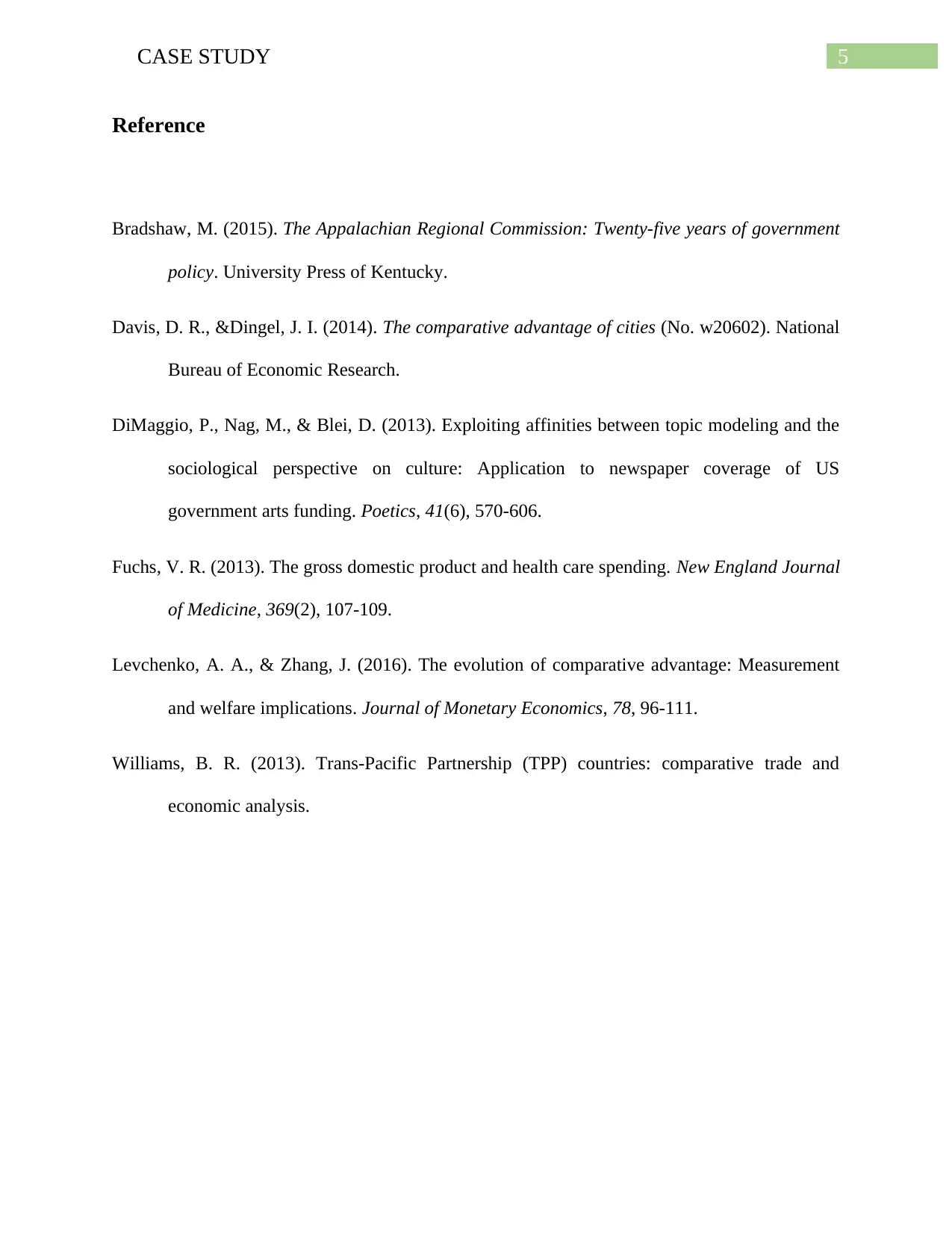
5CASE STUDY
Reference
Bradshaw, M. (2015). The Appalachian Regional Commission: Twenty-five years of government
policy. University Press of Kentucky.
Davis, D. R., &Dingel, J. I. (2014). The comparative advantage of cities (No. w20602). National
Bureau of Economic Research.
DiMaggio, P., Nag, M., & Blei, D. (2013). Exploiting affinities between topic modeling and the
sociological perspective on culture: Application to newspaper coverage of US
government arts funding. Poetics, 41(6), 570-606.
Fuchs, V. R. (2013). The gross domestic product and health care spending. New England Journal
of Medicine, 369(2), 107-109.
Levchenko, A. A., & Zhang, J. (2016). The evolution of comparative advantage: Measurement
and welfare implications. Journal of Monetary Economics, 78, 96-111.
Williams, B. R. (2013). Trans-Pacific Partnership (TPP) countries: comparative trade and
economic analysis.
Reference
Bradshaw, M. (2015). The Appalachian Regional Commission: Twenty-five years of government
policy. University Press of Kentucky.
Davis, D. R., &Dingel, J. I. (2014). The comparative advantage of cities (No. w20602). National
Bureau of Economic Research.
DiMaggio, P., Nag, M., & Blei, D. (2013). Exploiting affinities between topic modeling and the
sociological perspective on culture: Application to newspaper coverage of US
government arts funding. Poetics, 41(6), 570-606.
Fuchs, V. R. (2013). The gross domestic product and health care spending. New England Journal
of Medicine, 369(2), 107-109.
Levchenko, A. A., & Zhang, J. (2016). The evolution of comparative advantage: Measurement
and welfare implications. Journal of Monetary Economics, 78, 96-111.
Williams, B. R. (2013). Trans-Pacific Partnership (TPP) countries: comparative trade and
economic analysis.
⊘ This is a preview!⊘
Do you want full access?
Subscribe today to unlock all pages.

Trusted by 1+ million students worldwide
1 out of 6
Related Documents
Your All-in-One AI-Powered Toolkit for Academic Success.
+13062052269
info@desklib.com
Available 24*7 on WhatsApp / Email
![[object Object]](/_next/static/media/star-bottom.7253800d.svg)
Unlock your academic potential
Copyright © 2020–2025 A2Z Services. All Rights Reserved. Developed and managed by ZUCOL.




